San Diego Zoo breeds botanical riches
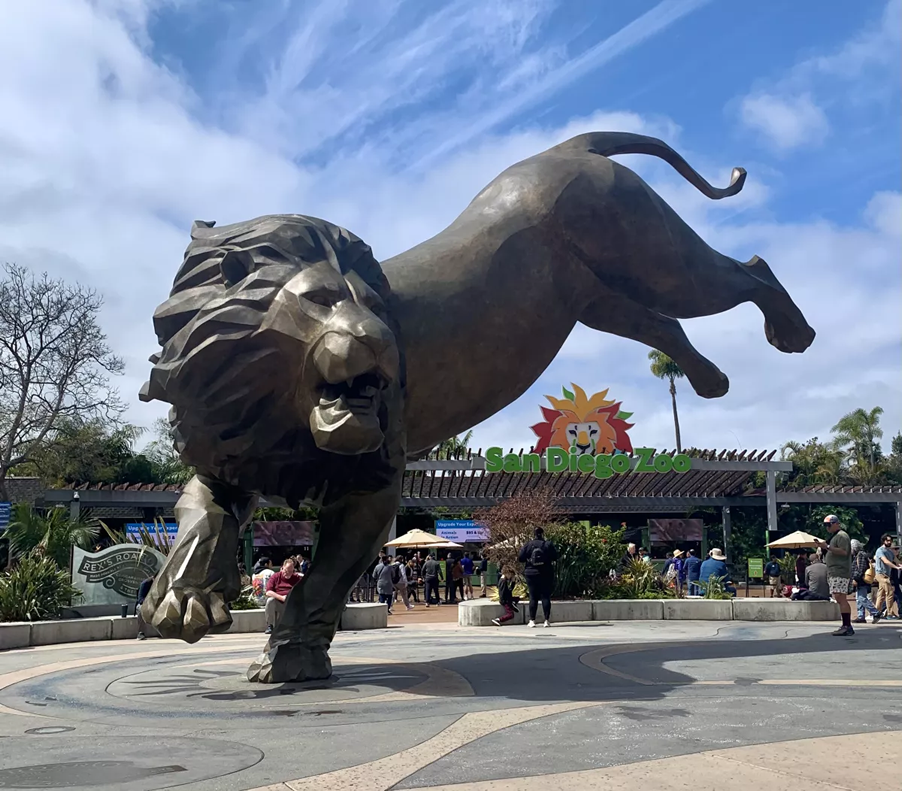
Rex the lion, a monumental 27-foot bronze sculpture, is waiting to greet visitors at the San Diego Zoo’s entrance plaza. It makes for a grand entrance to one of the grandest zoos in the world. But the animals aren’t the only draw.(Helen Purcell Montag)
With a focus on conservation, zoo’s vast plant collections featuring rare and unusual specimens are a whole other animal
BY HELEN PURCELL MONTAG
(This article originally appeared in the May 13, 2023 edition of the San Diego Union-Tribune)
Waiting to greet you at the San Diego Zoo’s entrance plaza in Balboa Park is a 27-foot bronze sculpture of a lion named Rex. What a grand entrance for one of the grandest zoos in the world! The commemorative plaque marking its 2016 centennial anniversary captures the story of the zoo’s beginnings: “Rex’s Roar — One Man — One Lion — One Encounter.”
The man was Dr. Harry Wegeforth, a physician for the Panama-California Exposition. Rex was the lion, just one of the exotic animals on display at the 1915-1916 exposition. The encounter was Rex’s “roar,” heard by Wegeforth as he drove by.
It was Rex’s roar that inspired Wegeforth to start a zoo. He purchased the menagerie of exotic animals that were left over when the Expo ended, formed the San Diego Zoological Society in 1916, and served as its president for the next 25 years.
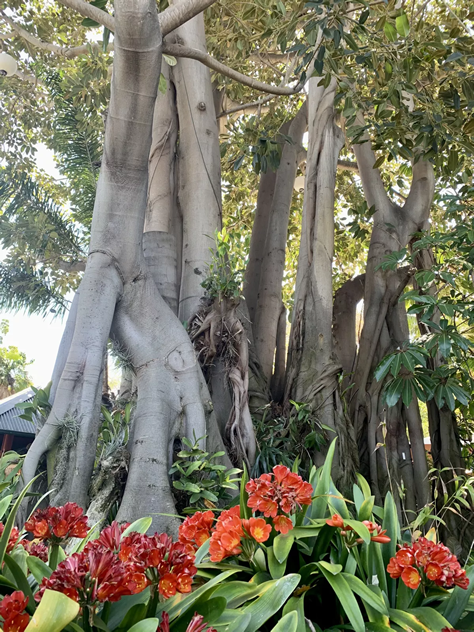
Tree canopies attract and sustain wildlife, help regulate our global climate, and on hot days, there’s no better place to be. Find the trails that are home to tree species from the rainforests of Asia, Africa, and Eastern Australia. On Monkey Trails, look for the giant Moreton Bay Fig (Ficus macrophylla).(Helen Purcell Montag)
Today, the San Diego Zoo is managed by the San Diego Zoo Wildlife Alliance (SDZWA), whose stated mission is “saving species worldwide by uniting our expertise in animal care and conservation science with our dedication to inspiring passion for nature.” San Diego Zoo’s leadership is at the forefront of conservation and collaboration in action and has partnered with the Center for Conservation Research, the largest zoo-based science center of its kind.
In addition to their efforts in animal conservation, the San Diego Zoo has a remarkable collection of rare and unusual plant species. SDZWA’s Institute for Conservation Research houses the Native Plant Seed Bank that includes seeds and specimens from our county’s rarest native plant species. An example of local collaboration is SDZWA’s work with the San Diego Botanic Garden to conserve collections of the vulnerable Cedros Island Oak (Quercus cedrosensis) using tissue culture techniques.
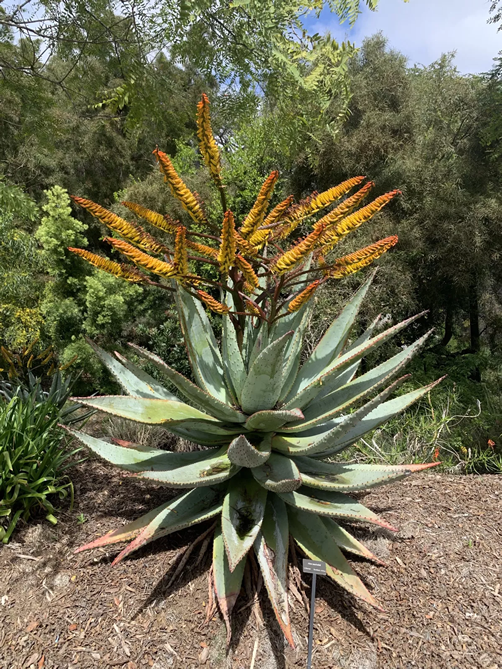
With their dramatic shapes and bright flowers, aloe plants are a gardener’s delight. Look for many aloe species throughout the Africa Rocks exhibit, including this mountain aloe from South Africa, Aloe marlothii, and learn to appreciate them even more for the nourishing nectar they provide to the wildlife in many of Africa’s arid and semi-arid habitats.(Helen Purcell Montag)
The zoo’s 100 acres of canyons and mesas in Balboa Park are a botanical home to a collection of 3,100 species of plants. From 1916’s scrub mesa chaparral to today’s paradise of luxuriant plants, did you know that the San Diego Zoo is also a botanic garden? Recognizing eight of its plant collections as well as its achievements in plant conservation, the zoo has been accredited by the Botanic Gardens Conservation International.
New or returning visitors marvel when they visit the zoo’s leafy botanical wonderland, represented by plant species from habitats around the world. If you visit on one of the many “Plant Days,” take the botanical bus tour. With a horticulturalist aboard as your guide, you’ll view outstanding species of aloes, bamboos, cycads, orchids, coral trees, palms, figs and carnivorous plants. The zoo also offers self-guided plant tours with brochures.
Explore greenhouses
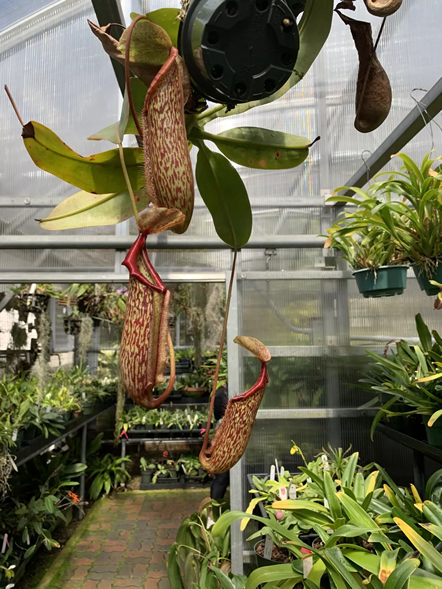
Visit the Orchid and Carnivorous Plant greenhouses to learn more about plants that have developed specialized trapping mechanisms to attract or trap insects, supplementing their need for vital nutrients. You’ll see tropical pitcher plants (Nepenthes hybrids) that lure insects into their slippery “pitcher”-shape leaves.(Helen Purcell Montag)
The recently remodeled Orchid Greenhouse is a showstopper. Orchids are highly desirable, and many species have been illegally traded to the point of extinction; the greenhouse is a “Plant Rescue Center” for confiscated species. Its horticultural staff works to preserve these plants through division, hand-pollination or micro-propagation. in the tiny-but-mighty Carnivorous Plant Greenhouse, you’ll see the Venus Flytrap (Dionaea muscipula) with hinged leaves that close to trap prey, and the Tropical Pitcher Plant (Nepenthes spp.) that lures insects into its slippery “pitcher”-shape leaves.
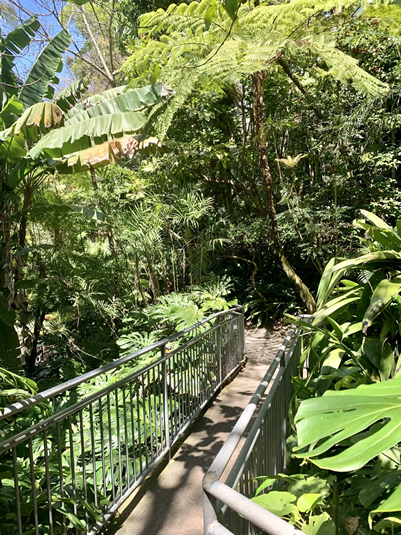
Fern Canyon and its landscaping began as a 1930s Depression-era project. Enjoy this garden’s shady, meandering pathways top-to-bottom. At every turn you’ll see a leafy wonderland of palms, ferns, bromeliads and more. The jacarandas (Jacaranda mimosifolia) and tall eucalyptus trees here are among some of the oldest planted at the zoo.(Helen Purcell Montag)
Walk under tree canopies
Tree canopies attract and sustain wildlife, help regulate our global climate, and, on hot days, there’s no better place to be. Download the zoo map or app and find the oldest garden at the zoo, Fern Canyon. Its shady and winding paths invite you to view species of Chamaedorea palms with arching leaves and narrow, bamboo-like ringed stems. There are ferns with leaves (called fronds) of all shapes and sizes, including the very large Australian tree fern (Sphaeropteris cooperi). Return in late spring or early summer, and you’ll be rewarded with jacaranda trees (Jacaranda mimosifolia) in bloom. Along with eucalyptus, they are some of the oldest trees planted at the zoo.
Find the trails that are home to tree species from the rainforests of Asia, Africa and Eastern Australia. On Monkey Trails, you’ll see two giant fig trees: Moreton Bay Fig (Ficus macrophylla) and Watkins Fig (Ficus watkinsiana). Walk down Tiger Trail’s meandering pathways to view lush bamboos or trees with unusual shapes like the sausage tree (Kigelia africana). From Bashor Bridge, as you look out toward the lush tree canopies, remember that 100 years ago, the land below was covered with scrub mesa chaparral.
Visit new exhibits
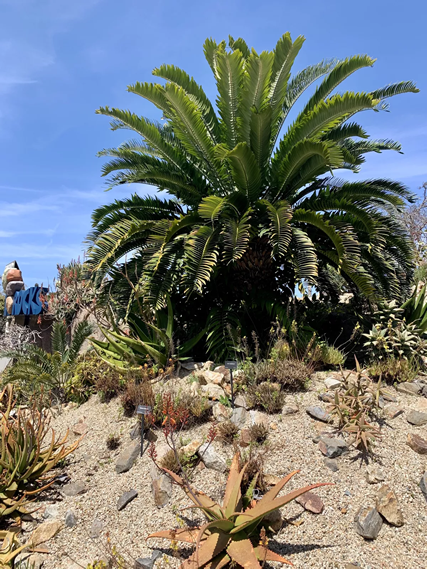
Cycads represent one of the most endangered plant groups in the world, as many species are under threat from extinction due to habitat destruction and poaching. The San Diego Zoo’s accredited collection of cycads represents over 100 species, including the Wood’s Cycad (Encephalartos woodii), now extinct in the wild, which you’ll find at the top of Africa Rocks.(Helen Purcell Montag)
The newest zoo exhibits inspire visitors to learn about rare plant species and experience new habitats. Future conservationists of all ages will be drawn to the Wildlife Explorers Basecamp’s mix of learning and play at the desert dunes, wild woods, marsh meadows and rainforest habitats. Enjoy the pathways of Africa Rocks top-to-bottom to view the extraordinary biodiversity of African species and six of the continent’s habitats, including those from Madagascar, the island country off its southeastern coast. Look for ancient cycad species, some of them extinct in the wild, and aloes with dramatic colors and shapes.
The San Diego Zoo’s horticulturalists reinforce SDZWA’s mission as they plan, advise and care for the botanical collections. Not only do the plants enhance the habitats of animals, they reinforce the importance of plant conservation for rare and critically endangered plant species. Come see for yourself.
Purcell Montag is an active UC Master Gardener who also enjoys history, travel, writing, genealogy and speaking Spanish.

